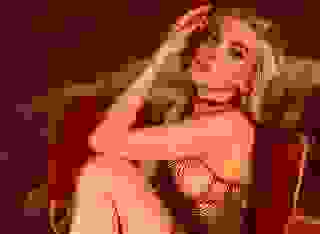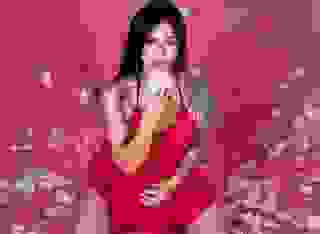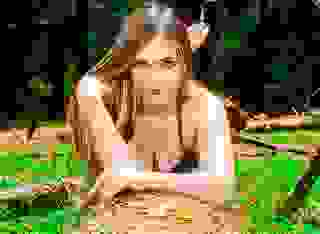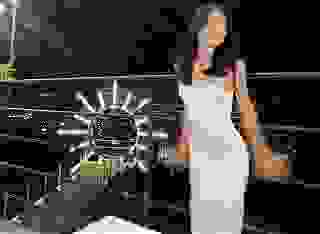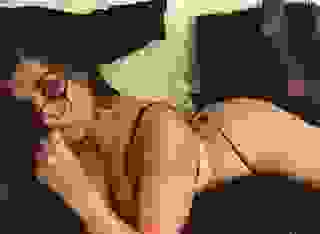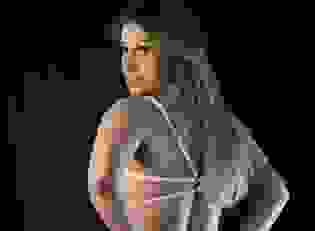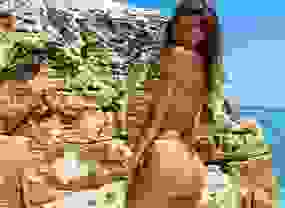Note: You can change font size, font face, and turn on dark mode by clicking the "A" icon tab in the Story Info Box.
You can temporarily switch back to a Classic Literotica® experience during our ongoing public Beta testing. Please consider leaving feedback on issues you experience or suggest improvements.
Click hereThe name of this red dwarf star is Proxima Centauri, and it is the closest star to Sol. It would not be discovered until at least 1915. It was so dim that the other two stars overtook it easily. Thankfully, this is not an issue for us as we get closer to the red dwarf star. It may be dim, but it has an exciting look to it. With it being so faint, the heat is less intense and produces a red glow for the light spectrum. We have to get closer and closer to it, to the point, we are near it.
We are still listening to the sounds of the cosmos. You can hear the change of the sounds as you listen to it. Red dwarf stars often create a deep purr sound to it. There would be a slight ring that would resonate up and down while the purr continues. Unfortunately, The heat given off is much less than Sol. Red dwarfs are so cool that tungsten can possibly withstand its temperatures. There are advantages and disadvantages to these small little stars that consist of three-quarters of the known stars in the Milky Way Galaxy.
As we turn our view away from the star, we see a planet orbiting it. In fact, there are a couple of planets that orbit this very star. The second planet alone was discovered in 2020. Red dwarfs live for so long that planets have plenty of time to enjoy the dull gaze of these small stars. Life has plenty of opportunities to develop in these worlds. The star isn't going anywhere, and planets will simply remain in orbit of the star forever until something much larger rips it away.
There is one problem with this form of thinking. Humankind had high hopes of finding a habitable world on Proxima Centauri B, its closest orbiting planet. The heat generated from the red dwarf was low, but the exoplanet was also very close to the star. The range alone allowed it to gather the same amount of heat as Earth was to Sol. The planet was tidally locked as well. Much like Luna was to Earth, the planet had one side perpetually stuck aiming itself to the star. There are no days on these planets, only years. Eleven days was the time it took for this planet to orbit its star. It receives proper temperatures......but when we look at it, we see little on the surface. It is seemingly barren and rocky. One side is a desert, while the other side is ice and darkness.
There is a significant problem when it comes to settling on red dwarf planets that humanity is all too aware of. Batrice and Gillan are prime examples of this very issue. Our gaze focuses on Proxima Centauri. We begin to see something happen on the photosphere of the star. An event is about to transpire that we are all too aware of......but it is far more potent than anything seen before.
We watch as the star's surface layer starts to get brighter and brighter. The luminosity is intense. It is more glorious than anything you have ever seen before. The side of the photosphere of Proxima Centauri begins to glow absolute white in pure light. You have to look away from it. The brightness is that intense. Once your eyes finally adjust, you can see what is happening. A massive ring of superheated plasma is being ejected from the red dwarf star. It is absolutely gigantic. Even if Proxima Centauri is 33 times smaller than Sol, it has managed to outperform the G-Type star in this particular task.
Witnessed as far back as 2016, you see a superflare from Proxima Centauri. It is a thousand times more substantial than a solar flare. It is not going to stop anytime soon. Sol's most powerful flares are measured in the tens long ago. These red dwarf stars are measured in the hundreds of thousands. The star has become a weapon of mass destruction. The planet that was enjoying its nice golden glow of heat and life is about to get slammed by the intense heat that Proxima Centauri is about to deliver to it.
The planet has to be much closer to the star to enjoy the same temperatures as the former people of Earth. This combined with the superflare, has proven to be a violent and deadly combination. The surface of the planet will rise for several degrees as the superflare is focused at it. Radiation levels go up as twenty times the normal limit. Like a laser cannon, Proxima Centauri is giving its planet a bloodbath of intense radiation and heat.
This event is why Proxima Centauri B has little to offer to humanity. If this was Earth and Proxima Centauri was blasting it, then within a few years of repeated flares, the atmosphere would be ripped away, and all life would be dead. It is why most of these red dwarf stars have also been named "Flarestars."
Perhaps it isn't truly Proxima's fault for doing all this and ending humanity's hope of finding life in the nearby star system. The red dwarf star is young. Some argue that other stars messing with its magnetic field like the other two sisters are to blame. Some say that fast-spinning red dwarf stars cause these massive superflares. Some argue that older red dwarfs are far less volatile. Regardless, over two-thirds of the red dwarfs found are flarestars as well.
The brightness is too much to bear. You are tired of having to close your eyes. You can see the faint outline of the stretched out rubber band ring as we start to getaway. Do you wish to go somewhere else? If humanity isn't living here, then where did they go?
Maybe one day, humanity will place a mining colony on Proxima Centauri B, but not today. This is not where we are supposed to be. It seems we keep finding ourselves in one hell to be replaced with another. We start to zoom away from it. The further and further away we get from the star, the more your eyes can finally adjust to the massive solar flare. We fly away from it. We must find our destination. You feel yourself being thrown for light-years of travel. Humanity has been given a gift that it has used well. The most significant discovery to usher the name Gabatrix, it is a name to be proud of.....for we now have the ability to fold space.......
From Sol, we have made a jump of over 29 light-years. Stars of other solar systems zip past us as we start to get closer and closer to our final destination. It was initially called Gliese 849. You watch as another red dwarf star comes into view. Much like Proxima Centauri, the looks are similar.
Ugh.....another red dwarf star. You already saw one of them. Now you see another? We already know the story of these things, but it is the prior knowledge that we learned that we now know a miracle had taken place. Life always finds a way to survive, and that miracle is Aphadus.
Gliese 849, much like the other red dwarf stars, was pretty much written off by the United World's Alliance. Humanity had found Cebravis and other colony worlds to live. A red dwarf habitable exoplanet? You might as well be laughed out of the stadium. In reality, that is where the argument comes to an end.
We start to zoom in on the closely orbital planet to this red dwarf star. Far, far in the distance, are other planets, but they are scattered in vast distance ranges. One planet in the system takes almost ten years to orbit its parent star. One world though, is close to the star. There should be no life on it, but there is. Your eyes befall that of an eyeball planet. This planet is tidally locked. One side is a desert, and the other side is a frozen dark spot.
What is often called "The Cebravis of red dwarf exoplanets," the planet Aphadus has defied the logic of what can be defined as a habitable planet. The music of the cosmos starts to fade as we no longer listen to the electromagnetic waves. Instead, we get closer and closer to this exoplanet. Much like any planet of a red dwarf star, this planet is very close to its star. Around the distance of around nine million kilometers of its parent star, Aphadus makes the distance between Mercury and Sol of 66 million kilometers look like a joke. The red dwarf is a spec when compared to Sol.
There are advantages to this star system, though. The biggest advantage is that the star is much older than it appeared to be when it was explored. Gliese 849 turned out to be one of the calmest red dwarf stars out there. It was a lonely star in the cosmos, and its superflares were almost nonexistent. It was a quiet star and one that had planets that were too far away from it or very close to it. Aphadus simply enjoyed the consistent rays of the star while turning it into a light red color. The planet is larger than Earth, and it has life on it. Where there is a will, there is a way for life to evolve on these planets. The planet is tidally locked to one side, but even tidal locking does not mean the planet still wobbles in orbit. Much like Luna and Earth, tidally locked planets still struggle and shake in the grip of its stars. This small wobble allows the air and atmosphere to circulate around the planet, creating a basic weather pattern.
We get closer and closer to Aphadus. We can see one side that is lit that has nothing but a substantial orange desert. Cooked from one side of the planet, it was rough for life to exist there. It makes the former deserts of Earth look like a sandbox in a children's playground. The other side of the planet is dark and cold. Nothing is located there because humanity does not wish to live there. So, where do the people of Aphadus live?
Eyeball planets, the name for tidally locked planets often have a unique advantage. If one side is too hot and one side is too cold, where does anybody live? The answer is rather obvious. Between hot and cold is the area where the sunlight still reaches but is partially dim. This is what is known as "The temperate zone" or "The Goldilocks zone," a place where the temperatures level out. It is here that life flourishes for a planet of this type.
We get close enough to the planet that we can see the basic weather patterns in place. Clouds of carbon dioxide and oxygen circulate around. We zoom in to a place that might be called the North Pole of Aphadus. We can see what looks like a forest that begins to define the zone where the heat is too much for life to develop and places where the desert begins to fade away. Ice from the other side of the planet is too warm to freeze, creating large lakes at the edge of the sunlight. Some of the plant and floral life is green by the desert, but as we get to the edge, we can see that the plants are black. With little light reaching the planet, the floral life had to evolve to embrace whatever sunlight that it could receive. Black leaves are the only way even to allow photosynthesis to take place. With plant life, oxygen is made, and there is a basic eco structure for small plants and even tiny animals to exist. This means that the extended circular boundaries that define the north and south poles are one giant ring of wildlife. This is why these planets are eyeball planets for their appearance.
Instead, we start to zoom further and further into the orbit of this miracle planet. We are so close that we can see two Magellan Class Battleships, a Nelson Class Battleship, and leased over T'rintar Battleships orbiting near a giant ring array. The array station that is tethered to the world looks like a giant ankh that is stabbed into the ground. The top of the station is the massive gate ring array that is connected to a large bar. The bar has commercial space vessels parked to it while in between both it and array was a centripetal habitation ring spinning to generate gravity for the numerous staff onboard. The tether circulates goods in and out of the station to the planet below it. We zip past the warships as we get so close to the station that we see a name written in both English and Chinese. The name "Fort Golconda," is written on it. The lonely planet is a colony for millions of people to live on. Most of the planet is still uninhabited and located by the great tether. We turn our sights directly down towards the planet. We feel the gravity pull us down to the great blackness of purple-colored lakes and towering black trees. It is seemingly dark here, but there is still enough light from the star that we can see the lit-up buildings below.
Faster and faster we go, we near the city of New San Antonio, the capital of Aphadus. Owned by the United World's Alliance, this small populated world enjoys the lifestyles and freedoms that Martians had little. When the ability to fold space was discovered, humanity had choices on what planets to live on. For many of the former people of North America and India on Earth, Aphadus was their choice. We finally break through the ozone layer as we near a wide variety of dome-like structures. The tether goes straight to the center of the most massive dome structure. Like looking at a bubbling surface of the water, the dome-like structures dot the entire scene. Forests take up some of the areas in between the domes, but we also see gray passageways that connect between them. The lights inside the domes almost look like glowing light bulbs that jut from the surface.
We reach near the end of this great journey through the cosmos where our story ultimately begins. Near the edge of the great city of New San Antonio is a blue dome structure. We reach the ground as we now look at the vast dome building. It is the United Human Naval Forces headquarters of the planet Aphadus. In the distance, we get to see Aphadus's star glowing red over the surface. It is around the same size as Sol is to Earth, but we will never see this star wholly set. Instead, we turn our sights toward other dome-like structures that are connected to the UHN headquarters. The domes seem to look like small houses. Windows perforate its sides as there is a door in the front and back.
As we fly into the small dome-like building, we get a chance to see the inside of this small 24th century home that humanity has to offer. A man is busy working behind his desk. Dressed in officer's clothes, he has a gold bar that sticks on the top collar of his UHN red and blue uniform. He holds a tablet in his hand as he appears to be browsing over things.
The home has everything that he needs. Circular based homes still have a toilet, a washroom, a bedroom, furniture, and kitchen appliances. The rooms are sparse but enough for the man to operate and live happily.
The man stands up from his desk as he heads over to the couch. He seems to be waking up as he gives out a long yawn. He still holds the tablet in his hand as he goes and sits by a large green sofa. He pauses as he thinks quietly to himself.
This individual has the name tag "Javier" on his uniform. He appears to be of mixed ancestry. If this were Earth, he would have some facial features of that of the South Americans and North Americans. He seems to be in his early twenties. He has brown hair and has a beard and mustache. His brown eyes scan the large tablet as he remains in contemplation.
"Ugh.....have to make sure this history report is correct," Ensign Javier said to himself. "The meeting is going to be in another few more hours. Did I get the report on the Itrean recent history correct?"
He put his finger to the display as he swiped it. He quickly reviewed everything as the data displayed for his eyes to scan. He swiped more data for him to look at. He could see the text appear as he read it.
"Nah, I did miss something," he said again. "I keep mislabeling the Yutilians as descended from the Deinonychus species. They are clearly Velociraptors. I need to stop watching that movie. I need to make those final corrections.....I did get the Aksren correct though......"
He used his finger as he highlighted the mislabeled text. He then typed it down to erase and record the correct information.
"Too bad, we still don't have enough to label the exact species of where the Shal'rein come from. I hate just labeling them as descended from sharks. Earth had plenty of shark species.....just which one did they come from?" he paused for a little bit. "Eh....it doesn't matter. It's not like anyone looks at their damn history books anyway.....err science books, I guess in this case."
Javier went and stood up as he looked at the clock. He tapped the pad of his tablet as the shudders of the window opened up. He could see the outside again.
"Crazy that others have days," Javier commented as he saw the dim red glow come into his home. "Imagine it becoming night and day.....what nonsense....."
As he looked at the clock, he could see it labeled 0702. If the world spun, it would be morning. He felt a sense of urgency as he went and closed down his tablet. He stood up as he walked over to the refrigerator. He opened it up and saw that it was virtually empty.
"Damn, Javier.....," he said to himself. "I need to make sure that I stop by the commissary. Even an officer needs to eat. Looks like I am going to the galley to eat. I wonder if Cason is there? I wouldn't mind getting a chance to sit down and eat with him. I wouldn't mind preparing my history report to the chain of command by talking to him."
He closed the door of the refrigerator as he looked at himself one last time. "Well....I guess I look prim and proper for work, as always. He checked his black boots to see if they were shined up enough. His blue pants had a slight piece of lint on it as he pulled it off and let it fall to the floor. He checked the rest of his uniform as he gave a quick nod.
"Better looking than those UHN jumpsuits. Yeah....good enough to impress the staff.....errr.....at least if they get impressed at all."
He went and placed his computer tablet in his pocket. Without hesitation, he wiped his short brown hair as he walked over to a door. He pressed the button as it slid open to reveal the outside of the environment.
"Beautiful as always," he said to himself as he walked outside.
The door closed behind him as he looked at the dome cities in front of him. He had seen the place before many times, but it was the other direction where he wanted to look at the most. As he turned, he began to overlook the environment.
Javier had a nice set of scenery for a planet of this type to have. Located near his home was Lake Lonar, a massive lake consisting of the only beach that connected to New San Antonio. The light red glow of the star was perfect for his eyes to see. Even with less illumination, it was still easy to see the landscape, and it was less intense than the rays of outside on other planets. It made the lake look purple in color. He walked around on the dirt as he put his hands to his pockets. He gave a large scan of the landscape. For some reason looking at this made him feel better.
He took his hand as he looked at the small plants. The black leaves were significant as he tapped one of the leaves.
"Well.....I need to get to work," he said to himself. "I need to get some food."
With that, the officer turned back to his home. It was connected to the UHN headquarters building. He could simply ride the transport tunnels and get to the place that he needed to eat and report to work. The door opened up as he walked back inside the home. The door closed as he knew where to go next.
Chapter 2: It Was a Typical Day....
"Cason, there you are!" Javier said as he carried his food tray towards the table his friend sat at.
It was a Tuesday morning on a colony world that had a never-ending day. It had been thirty minutes later as Javier carried a tray with banana, coffee, and an egg sandwich on his tray. The galley and mess hall was enormous. UHN headquarters was a massive domed building of multiple rooms, offices, and administration for the military on Aphadus. If anything, it was the only real military base for the seemingly lonely planet in the solar system.
The food hall was massive in size and consisted of numerous tables for the large building. Tables of various sizes and crowds were established. Areas were sectioned off for enlisted, civilian, and officer alike. Only recently had the place been modified to allow a new set of visitors......the Itreans.
